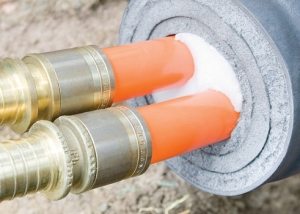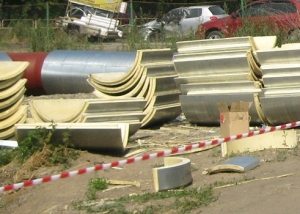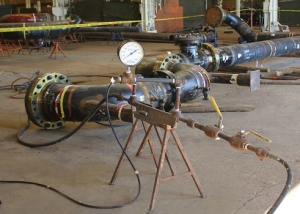There are usually three reasons why thermal insulation is needed for outdoor heating pipes for a private house. The first is when it is necessary to lay heating engineering communications along the street from the central heating main to the building. The second, when an autonomous boiler room is used for heating. Third, heating communications must be extended to other buildings located on the territory of the household.
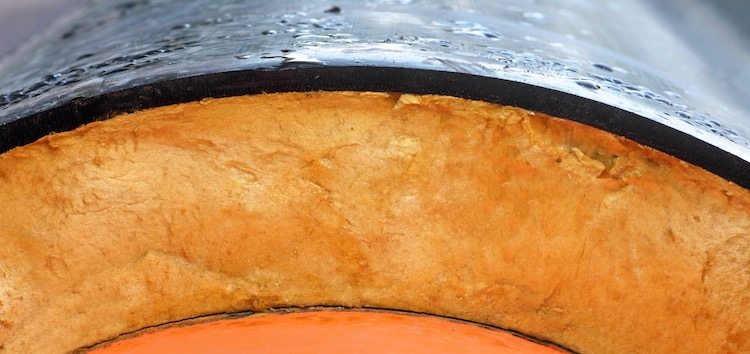
Content
Why is insulation for outdoor heating pipes carried out?
It would seem that the procedure for warming pipes for heating is an unnecessary activity: they are almost always hot anyway. Therefore, if we are talking about the insulation of pipes of heating systems, it would be more correct to use the term “thermal insulation”. This concerns primarily pipelines of hot water supply systems (Hot Water Supply). Here, not warming comes to the fore, but maintaining the temperature of the pumped medium at a certain level and reducing heat loss. The same precaution will not be out of place for domestic hot water pipelines and for heating routes, regardless of the type of pipe itself - steel, copper or plastic.
Helpful advice!Sometimes insulation of heating pipes for laying in the ground, made using only traditional thermal insulation, is insufficient. In this case, experts recommend heating them forcibly using heating cables.
Pipeline heat exchange area
The cylindrical configuration of the pipes determines a considerable area of heat exchange with the atmosphere or soil (if they are laid in the ground). As the diameter of the pipeline increases, heat loss increases. From the table below you will find out how critical their increase is to the temperature difference outside and inside the pipe, from its diameter and the thickness of the insulation layer.

Insulation Material Requirements
In the modern market, in the segment of thermal insulation for heating pipes in the open air there are many offers. It is necessary to give preference to the following heat-insulating structures:
- For the insulation of heating pipes on the street, as well as in the basement, only hydrophobic material is suitable.
- Thermal insulation of heating pipes must have reliable external protection. The reasons for this requirement lie in both natural phenomena and the human factor:
- if the insulation is able to absorb water, it must be reliably protected from atmospheric moisture;
- external protection will not allow the destruction of pipelines on the street from the negative effects of UV radiation;
- External protection withstands excessive wind load.
In addition, one cannot exclude the possibility of damage to the thermal insulation of the external hot water supply lines and heating by animals that are released to the infield, as well as from the banal manifestations of vandalism.
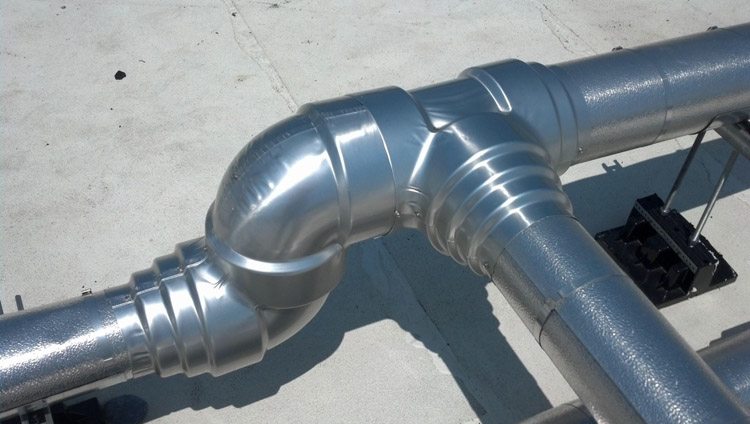
Thermal insulation criteria
In search of an answer to the question of how heating pipes are insulated on the street and in the attic, in addition to the above requirements, the following characteristics of the insulating material should be taken into account:
- thermal conductivity;
- ability to withstand aggressive environmental influences;
- Operating temperature range;
- service life.This is especially true if the pipes are laid in the ground, and not in the open air;
- ease of installation.
Thermal Insulation Options
A variety of materials provides the opportunity to realize high-quality thermal insulation of pipelines laid both in the ground and above its surface. And although the production of insulated pipes for heating in our country is established at a fairly high level, many of our compatriots carry out their thermal insulation on their own.
Of course, one cannot do without certain knowledge. Indeed, a wide selection implies a difference in the characteristics of insulating materials. Therefore, those who decided to perform this procedure without involving professionals, it will be useful to know that for the insulation of heating pipes with their own hands, the following are used:
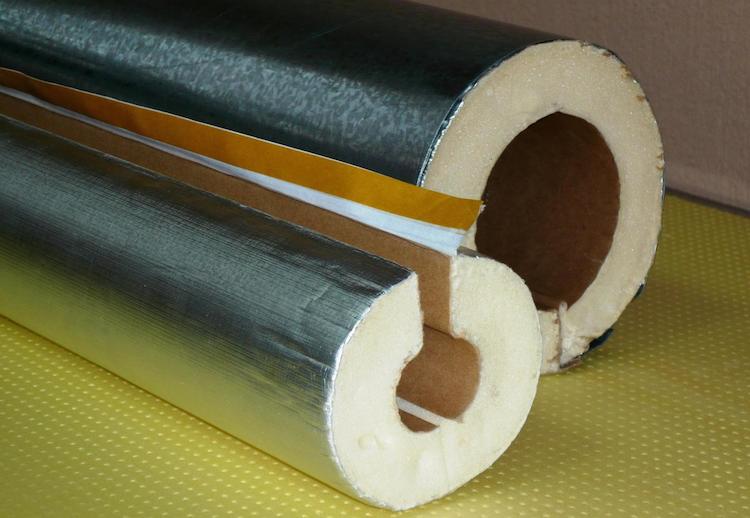
Foamed insulation. These products are available in the form of covers, for the manufacture of which polyurethane, expanded polystyrene or rubber is used. A thermal insulation layer is created without problems: the cover is simply put on the pipeline through a longitudinal section, and not by pulling the pipe through its cavity.
Helpful advice! If you will do itdo it yourself, do not forget at the final stage to glue the ends of the section with a special adhesive.
Special mineral wool.
- Basaltic. The raw material for its manufacture is rock with a high content of basalt mineral. This insulation attracts attention by the fact that, firstly, it is able to work at a temperature of + 650 ° C, and, secondly, it does not emit toxic substances when heated.
- Fiberglass. Quartz sand is its main component. In addition, the composition of such insulation includes glass made from it. Its peculiarity is a relatively low working temperature - about 180 ° C. Therefore, fiberglass wool is mainly used for the manufacture of pipes for heating insulated for external routes and for those laid in the ground.
Since both of these types of thermal insulation are characterized by increased hygroscopicity, they can be used only in combination with waterproofing:
- Reflective winding. The procedure for warming heating pipes on the street with your own hands with the help of such thermal insulation does not require the contractor to have professional skills. Everything is very simple. On top of the main layer of insulation, made, for example, of foamed polyurethane or polyethylene, wrap aluminum foil, and then fix it with a metal wire.
- Styrofoam. For utilities, special shapes repeating their geometry are made in the form of a ring consisting of two parts. In each of them there is a groove joint. This design makes it easy enough to insulate the pipeline with your own hands.
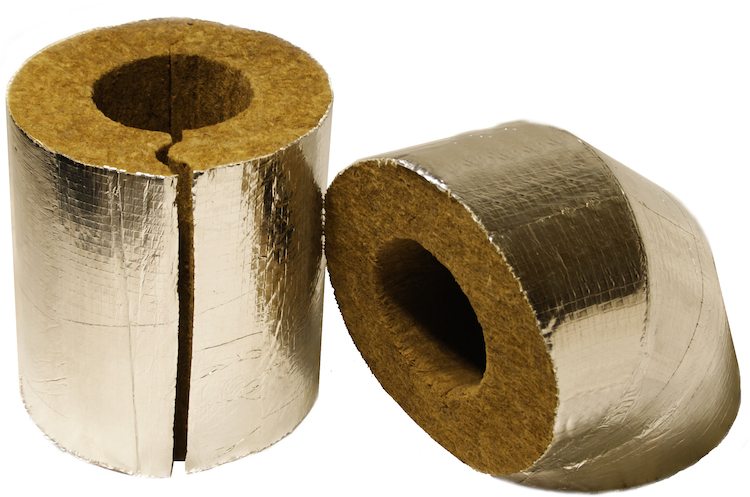
Helpful advice! Polyfoam practically does not absorb moisture. But since the insulation of hot water pipes istrails in the ground you need absolutely waterproof material, polystyrene is not the best option. From this point of view, it would be better to opt for extruded polystyrene foam.
Polyfoam is the best material for creating thermal insulation for heating pipes in an apartment. Not many of our compatriots understand the relevance of this issue. Yes, not on the street, but in a residential building, even non-insulated heating pipes will not freeze. But on the way to the radiator, useful degrees are spent on heating walls and furniture. Thus, the degree of heating of the radiator will be significantly less than the expected value, which, in turn, will lead to a decrease in the level of heat transfer to the rooms of the apartment.
Pipe insulation in the attic and basement
Having finished the construction of a private house, its owner must find out how the heating pipes are insulated. The choice of material depends on the type of room in which they are installed: in the attic or in the basement.
Attic It is characterized by increased blowing, therefore, increased humidity here, as a rule, is not fixed: it is the same as on the street. And for the reason that it is very difficult to create complete insulation in the attic, minus temperatures are not uncommon there.
Those who want to insulate the pipes laid in this room with their own hands should be guided not only by the indicator of thermal conductivity of the material. You should also consider whether it is possible to connect segments without the formation of cold bridges. As practice shows, for insulation of heating pipes in the attic, glass wool, slag, stone and basalt cotton wool are best suited. And not only because of the affordable price. After all, even for those who do not know how to insulate heating pipes in the attic, an independent solution to this problem is on the shoulder. And this is an additional savings.
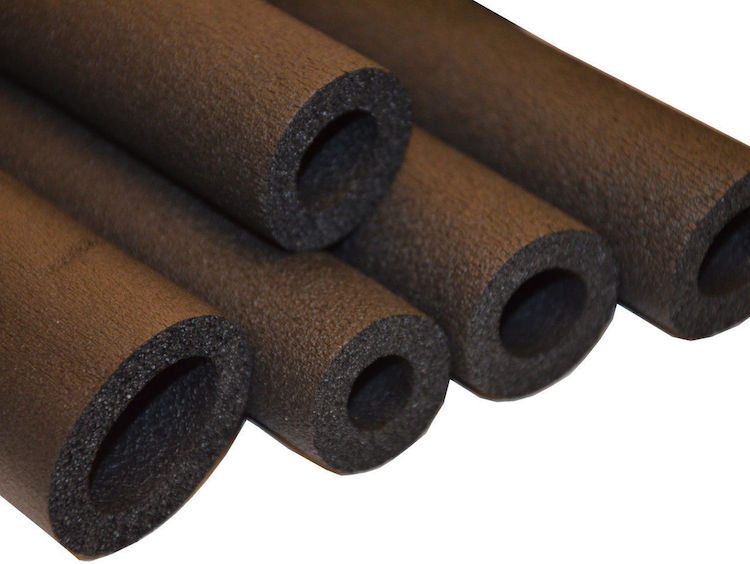
Basement- the most critical place for heating pipes in a residential building. They are laid in the ground below the depth of freezing of the soil. But even this does not exempt from the need for insulation of pipelines. And from the point of entry of the heating main into the basement to the place where the pipes fit to the location of the plumbing, they must be thermally insulated.
Helpful advice! Regardless of the type of material used for thermal insulation of pipes laid in the ground, it must be covered with a layer of waterproofing.
Finding the answer to the question of how to insulate heating pipes in the basement will not take much time. According to experts, in terms of price / quality ratio, the best choice is thermal insulation made of polystyrene foam. It is produced for pipes of different diameters and any owner can use it to warm the pipeline in the basement with his own hands.
The use of mineral wool involves the implementation of two stages of the process of warming heating pipes in the basement:
- the web is tightly wrapped around the pipe and secured with a nylon cord;
- waterproofing protection is formed from roofing material. Being pre-cut into pieces, this material, in turn, is wound on top of mineral wool. For fixing, a kapron rope is also used.
The correct choice of the heat-insulating structure and the correctness of its installation determine the duration of the operation and the efficiency of the pipelines.
